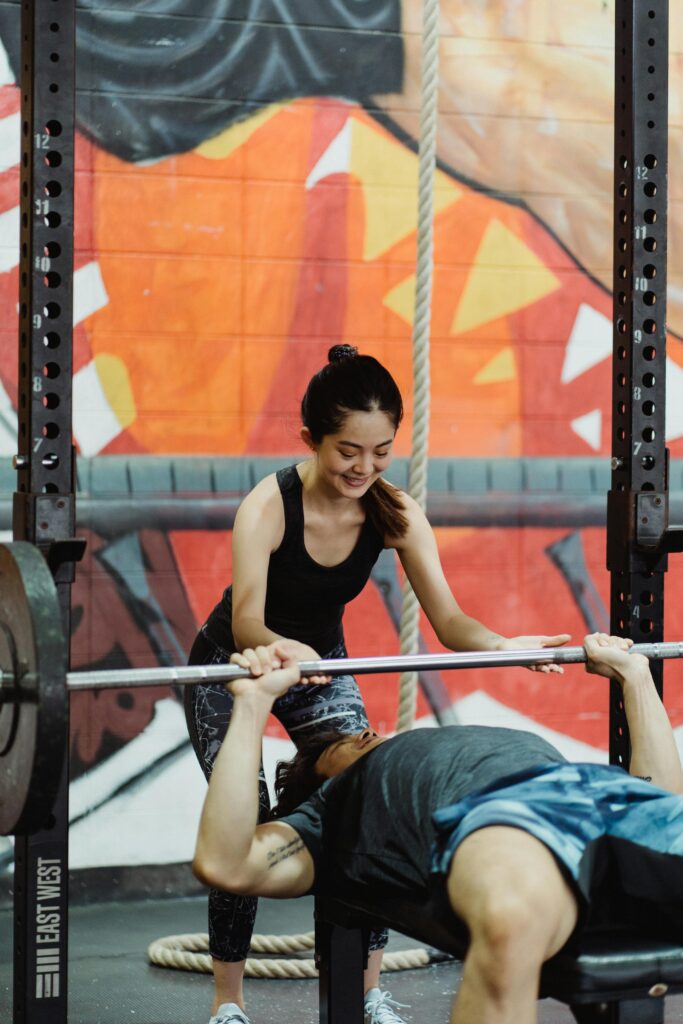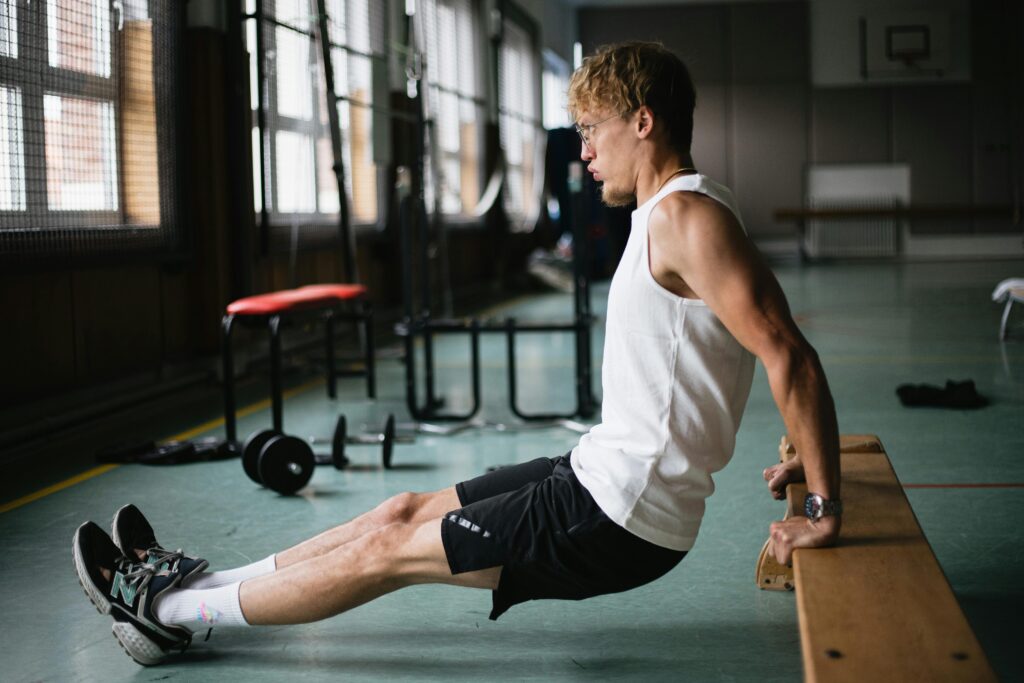Introduction:
workout at home with bench
in recent times, the convenience and flexibility of home workouts have become increasingly popular, especially for those with limited time or access to gym facilities. If you’re looking to elevate your home workout routine, incorporating a bench can take your training to the next level. In this comprehensive guide, we’ll explore a variety of effective exercises and tips for working out at home with a bench. Whether you’re a beginner or a seasoned fitness enthusiast, you’ll discover how to maximize your workouts and achieve your fitness goals without ever leaving the comfort of your home.
Table of Contents
Bench Press
Introduction: The bench press stands as one of the most iconic exercises in any workout at home with bench enthusiast’s repertoire. Whether you’re a seasoned lifter or a beginner looking to sculpt your physique, mastering the bench press is essential. In this comprehensive guide, we’ll delve into the nuances of the bench press, from proper form and technique to advanced variations, to help you achieve your strength and muscle-building goals.
Understanding the Bench Press: Before diving into the specifics, let’s first understand what the bench press is and why it’s such a fundamental exercise. The bench press primarily targets the chest muscles (pectoralis major), but it also engages the shoulders (deltoids) and triceps to a significant extent. Additionally, it serves as a compound movement, meaning it recruits multiple muscle groups simultaneously, making it incredibly efficient for building overall upper body strength and mass.
Mastering Form and Technique: Proper form and technique are paramount when it comes to the bench press, not only for maximizing gains but also for preventing injuries. Here’s a breakdown of the key elements:
- Setup: Begin by lying flat on the bench with your feet firmly planted on the ground. Grip the barbell slightly wider than shoulder-width apart, ensuring your wrists are straight and aligned with your forearms.
- Descent: Lower the barbell under control towards your mid-chest, keeping your elbows tucked at a 45-degree angle to your torso.
- Ascent: Press the barbell back up explosively, driving through your heels and maintaining tension in your chest, shoulders, and triceps.
- Breathing: Inhale as you lower the barbell and exhale forcefully as you press it back up.
Progressive Overload and Programming: To continually challenge your muscles and stimulate growth, it’s crucial to incorporate progressive overload into your bench press routine. This involves gradually increasing the weight you lift over time or manipulating other variables such as sets, reps, and tempo. Additionally, following a well-structured program that includes variations like incline bench press, decline bench press, and dumbbell bench press can help target different areas of the chest and prevent plateaus.
Common Mistakes to Avoid workout at home with bench: Even experienced lifters can fall victim to common mistakes that hinder progress and increase the risk of injury. Some of these mistakes include arching the back excessively, flaring the elbows out too wide, and bouncing the bar off the chest. By focusing on proper form and technique and being mindful of these pitfalls, you can optimize your bench press performance and stay injury-free.
Conclusion: The bench press is more than just a chest exercise—it’s a cornerstone of strength training and muscle development. By mastering the proper form and technique, incorporating progressive overload, and avoiding common mistakes, you can unlock new levels of strength and build an impressive physique. So, whether you’re aiming to increase your one-rep max or sculpt a chiseled chest, the bench press is a tried-and-true method to help you reach your goals.
With dedication and consistency, you can harness the power of the bench press to transform your body and elevate your fitness journey to new heights. So, grab that barbell, hit the bench, and let’s press towards greatness together!
workout at home with bench

Incline Bench Press
mastering the incline bench press! Whether you’re a seasoned gym-goer or just starting your fitness journey, the incline bench press is a fundamental exercise that targets the upper chest, shoulders, and triceps. In this post, we’ll delve into the proper techniques, benefits, and variations of the incline bench press to help you maximize your gains and achieve your fitness goals.
Understanding the Incline Bench Press: The incline bench press is a variation of the traditional bench press where the bench is set at an incline of around 15 to 45 degrees. This angle targets the upper portion of the chest muscles, emphasizing the development of the clavicular head of the pectoralis major.
Technique:
- Set up the bench at a desired incline angle, usually between 15 to 45 degrees.
- Lie back on the bench with your feet flat on the floor and your back, shoulders, and head firmly pressed against the bench.
- Grip the barbell slightly wider than shoulder-width apart, with your palms facing away from you.
- Unrack the barbell and lower it slowly and under control towards your upper chest, keeping your elbows tucked in.
- Pause briefly when the barbell touches your chest, then push it back up explosively to the starting position.
- Repeat for the desired number of repetitions.
Benefits of the Incline Press workout at home with bench
- Upper Chest Development: The incline angle targets the upper portion of the chest, helping to build a well-rounded and balanced chest.
- Shoulder Stability: The incline bench press also engages the front deltoids, contributing to shoulder stability and strength.
- Variation and Muscle Growth: Incorporating incline bench press variations into your routine can help stimulate muscle growth and prevent plateaus.
- Functional Strength: The pushing motion of the incline bench press mimics many real-life movements, making it a functional exercise for everyday activities.
Variations of the Incline Bench Press:
- Dumbbell Incline Bench Press: Using dumbbells instead of a barbell can help improve muscle balance and stability.
- Reverse-Grip Incline Bench Press: Gripping the barbell with an underhand grip shifts the focus to the upper chest and triceps.
- Smith Machine Incline Bench Press: The Smith machine provides added stability and control, making it suitable for beginners or those recovering from injuries.
Incorporating the Incline Bench Press Into Your Routine: To reap the full benefits of the incline bench press, it’s essential to incorporate it into a well-rounded workout routine. Aim to perform the exercise 1-2 times per week, focusing on proper form and gradually increasing the weight as you progress. Additionally, be sure to include sufficient rest and recovery to allow your muscles to repair and grow.
workout at home with bench

Decline Bench Press
When it comes to sculpting a well-rounded upper body, the decline bench press is a fundamental exercise that often gets overlooked. This powerful movement targets the lower portion of the chest, offering unique benefits and variations that can take your strength training to the next level. In this comprehensive guide, we’ll delve into the ins and outs of the decline bench press, covering everything from proper technique to advanced variations, and why it deserves a prime spot in your workout routine.
Understanding the Decline Bench Press: The decline bench press is a variation of the traditional bench press, that is good for workout at home with bench where the bench is set at a downward angle of typically 15 to 30 degrees. This slight decline shifts the focus to the lower portion of the chest, engaging the pectoralis major muscle fibers in a different way compared to flat or incline bench presses.
Technique:
- Set up: Lie down on a decline bench with your feet securely locked in place. Grip the barbell slightly wider than shoulder-width apart, ensuring a firm grip.
- Lowering the bar: Lower the barbell in a controlled manner towards the lower chest, keeping your elbows tucked at a 45-degree angle to your body.
- Pressing up: Push the barbell back up to the starting position, focusing on driving through your chest muscles while maintaining stability through your core.
- Breathing: Inhale as you lower the barbell and exhale as you push it back up, maintaining a steady breathing rhythm throughout the movement.
Benefits of Decline Bench Press: workout at home with bench
- Targeted lower chest development: The decline angle places greater emphasis on the lower portion of the chest, helping to sculpt a balanced and well-defined chest.
- Increased range of motion: The decline position allows for a deeper stretch in the chest muscles, leading to greater muscle activation and potential growth.
- Enhanced triceps engagement: While the chest muscles are the primary movers, the decline bench press also recruits the triceps to a greater extent, aiding in overall upper body strength development.
Variations to Spice Up Your Workouts:
- Dumbbell Decline Bench Press: Utilizing dumbbells instead of a barbell adds an element of instability, forcing stabilizer muscles to work harder.
- Decline Push-ups: A bodyweight alternative that can be done anywhere, decline push-ups mimic the motion of the decline bench press and provide an excellent chest and triceps workout.
- Reverse Grip Decline Bench Press: Gripping the barbell with a reverse grip (palms facing towards you) shifts the focus to the inner chest and emphasizes the involvement of the triceps.
Incorporating the Decline Bench Press into Your Routine: To maximize the benefits of the decline bench press, consider integrating it into your chest training routine 1-2 times per week. Start with lighter weights to perfect your form before gradually increasing the resistance. Remember to listen to your body and adjust the angle of the decline bench if needed to optimize comfort and muscle engagement.
workout at home with bench

Dumbbell Rows
Dumbbell rows are a staple exercise in any strength training routine, known for their ability to target and strengthen the muscles of the back, shoulders, and arms. Whether you’re a beginner or an experienced lifter, mastering the form and technique of dumbbell rows can significantly enhance your overall strength and muscle development. In this guide, we’ll delve into the intricacies of dumbbell rows, covering everything from proper form to variations and benefits, to help you maximize your results and achieve a stronger, more sculpted back.
Understanding Dumbbell Rows: Dumbbell rows primarily target the latissimus dorsi, rhomboids, traps, rear deltoids, and biceps. Proper form is crucial to ensure that these muscles are effectively engaged and to prevent injury. Here’s a step-by-step guide to performing dumbbell rows with correct form:
- Start by standing with your feet shoulder-width apart, holding a dumbbell in each hand.
- Hinge at your hips, keeping your back straight and chest up, and slightly bend your knees.
- Engage your core muscles to stabilize your spine.
- With palms facing inward, pull the dumbbells towards your hips, keeping your elbows close to your body.
- Squeeze your shoulder blades together at the top of the movement, then slowly lower the dumbbells back to the starting position.
- Repeat for the desired number of repetitions.
Variations of Dumbbell Rows: Variations of dumbbell rows can target different areas of the back and provide variety to your workout routine. Some popular variations include:
- Single-arm dumbbell rows: Perform rows with one arm at a time to focus on each side independently.
- Incline dumbbell rows: Perform rows on an incline bench to target the upper back and rear deltoids.
- Renegade rows: Perform rows from a plank position, alternating arms to engage the core and stabilizing muscles.
- Wide-grip dumbbell rows: Perform rows with a wider grip to target the outer lats.
Benefits of Dumbbell Rows: Incorporating dumbbell rows into your workout routine offers a myriad of benefits, including:
- Improved back strength and muscle development.
- Increased pulling strength, which can enhance performance in other compound exercises like deadlifts and pull-ups.
- Enhanced posture and spinal stability.
- Balanced muscle development, as dumbbell rows engage multiple muscle groups simultaneously.
Conclusion: Dumbbell rows are a versatile and effective exercise for building back strength and muscle mass. By mastering proper form, exploring variations, and consistently incorporating dumbbell rows into your routine, you can achieve significant gains in strength, muscle size, and overall fitness. Whether you’re a seasoned lifter or just starting your fitness journey, dumbbell rows are a valuable addition to any workout program. Start incorporating them into your routine today and reap the benefits of a stronger, more sculpted back.
By optimizing this post with relevant keywords, including “dumbbell rows,” “back strength,” and related terms, and providing valuable information and insights, we aim to improve its visibility and rank on Google’s search results for the target keyword “dumbbell rows.”
workout at home with bench

Bulgarian Split Squats
Bulgarian split squats are a great lower body exercise that targets the quads, glutes, and hamstrings. To perform Bulgarian split squats with a bench, stand facing away from the bench with one foot elevated behind you on the bench. Lower your body into a lunge position, keeping your front knee aligned with your ankle, and then push back up to the starting position. Repeat on both legs for an effective lower body workout.

Triceps Dips
Triceps dips are an effective bodyweight exercise for targeting the triceps. Sit on the edge of the bench with your hands gripping the edge beside your hips, fingers pointing forward. Lift your hips off the bench and walk your feet forward until your knees are at a 90-degree angle. Lower your body by bending your elbows until your upper arms are parallel to the ground, then press back up to the starting position. Triceps dips can be modified by adjusting the distance between your feet and the bench to increase or decrease difficulty.
workout at home with bench

Bench Step-Ups
Bench step-ups are a simple yet effective lower body exercise that targets the quads, hamstrings, and glutes. Stand facing the bench with your feet hip-width apart. workout at home with bench Step onto the bench with one foot, ensuring your entire foot is planted firmly on the bench, then drive through the heel to lift your body up onto the bench. Step back down to the starting position and repeat on the other leg. Bench step-ups can be performed with bodyweight only or with added resistance such as dumbbells or a weighted vest.
Bench Push-Ups
Bench push-ups are a beginner-friendly variation of the traditional push-up that can help develop upper body strength and stability. Place your hands on the edge of the bench slightly wider than shoulder-width apart, with your arms fully extended and your body in a straight line from head to heels. Lower your chest towards the bench by bending your elbows, then press back up to the starting position. Adjust the difficulty by changing the height of the bench or the angle of your body.
Bench Leg Raises
Bench leg raises are an effective exercise for targeting the lower abdominal muscles on bench into your home workout. Lie on your back on the bench with your hands gripping the sides for support. Extend your legs straight up towards the ceiling, then lower them back down towards the bench without letting them touch the ground. Keep your core engaged throughout the movement to prevent arching your back.
bench into your home workout
Conclusion:
Incorporating a workout at home with bench routine opens up a world of possibilities for building strength, muscle mass, and overall fitness. Whether you’re performing classic compound exercises like the bench press or getting creative with bodyweight movements, the bench can provide the stability and support you need to take your workouts to the next level. With these effective exercises and tips, you can create a challenging and varied workout routine that targets every muscle group and helps you achieve your fitness goals from the comfort of your own home. if you interesting another topics like this here our top recommended can you build muscle in a calorie deficit
thank you guys we love u





Pingback: Does Swimming Build Muscle ? Full Guide For Beginners - vikingfit22.com vikingfit22.com
Pingback: Can You build Muscle in a Calorie Deficit ? - vikingfit22.com
Pingback: The Best Testosterone Booster For Muscle Gain - Vikingfit22.com
Pingback: Top 6 Long Head Triceps Exercises - Vikingfit22.com